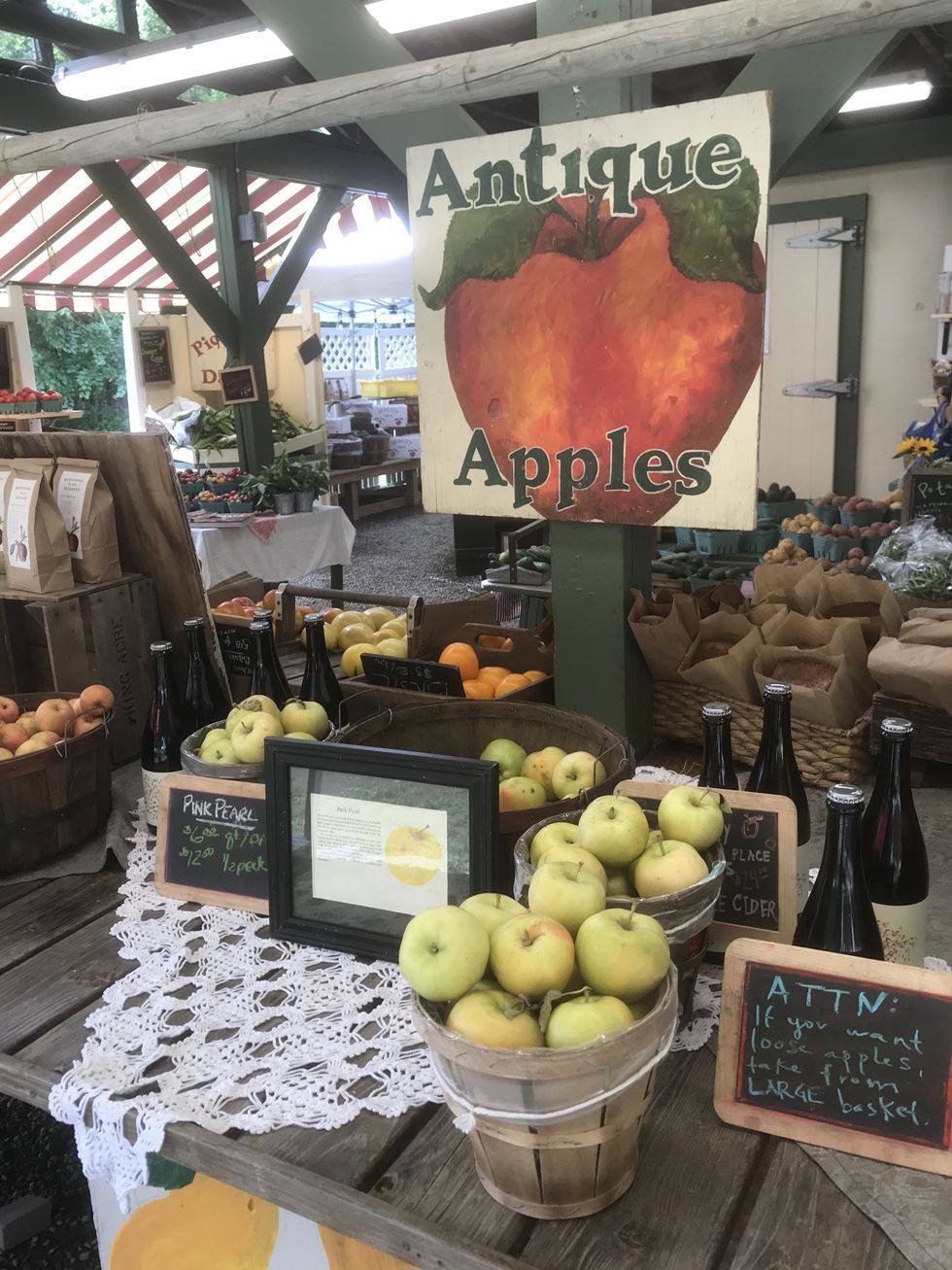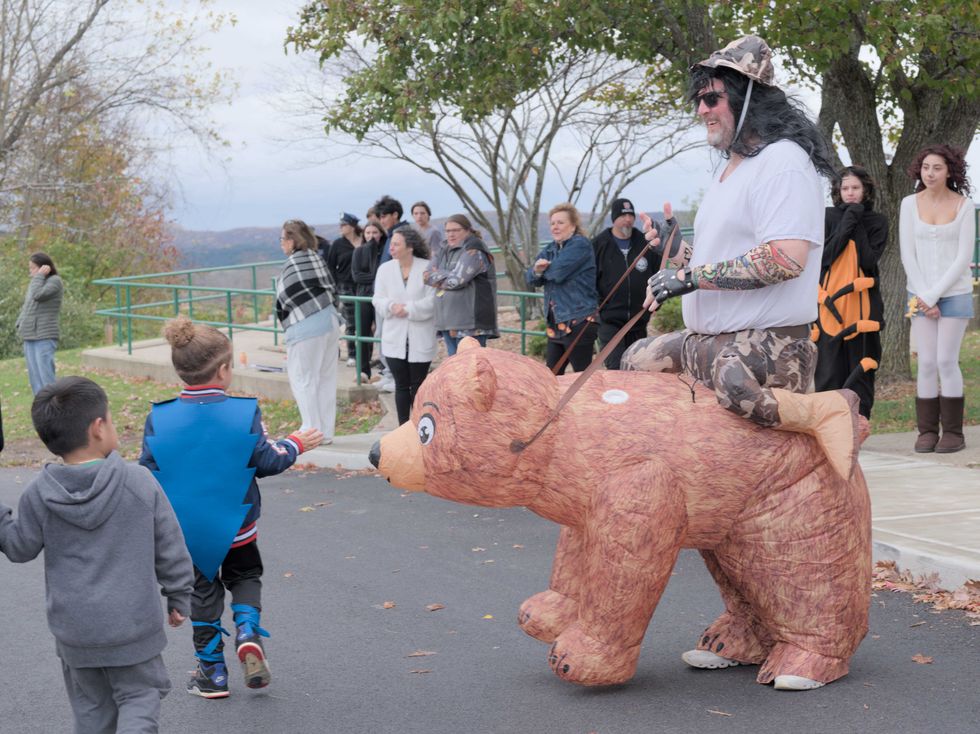Day Trips To Find Antique Fruit

If you’re aching for adventure after a long quarantine, take a day trip to Red Hook, N.Y., and get antique apples at the Montgomery Place Orchards farm stand.
Photo by Cynthia Hochswender

There are excellent orchards nearby where you can pick fruit for yourself or buy it pre-picked. Windy Hill Farm in Great Barrington, Mass., has five varieties of apple on offer now and will make other varieties available (including some heirlooms) as they hit their peak. Find out what they’ve got at www.windyhillfarminc.com.
Ellsworth Hill Orchard in Sharon, Conn., has 10 varieties of apples, and ancillaries such as cider and doughnuts, www.ellsworthfarm.com.
But this autumn, when so many other travel opportunities are curtailed, I’m thinking about making a day trip to someplace, maybe an hour away, to pick apples (with masks on).
About one hour from my home in Lakeville, Conn., is the excellent Love Apple Farm in Ghent, N.Y., a town famous for its cherries in spring and apples in autumn. Love Apple Farm supplies outstanding fruit throughout the year to many of our area farm stands. At the moment they have four types of apples but in all they have 19 varieties that will ripen in the coming weeks, www.loveapplefarm.com.
When you hear the names of some of their varieties you might think, “Gee, how ordinary.” But once you’ve tasted a golden delicious or a red delicious from a local orchard you’ll understand why everyone went crazy for these apples in their early days (so much so that they were overbred and perhaps ruined).
When I want to go hunting for apples I go to Red Hook, N.Y., which is 40 minutes away and also has good restaurants and cute shops.
If you want to pick your own in Red Hook, you can try Greig Farm (www.greigfarm.com), which has 11 types of apples that will ripen between now and October.
Up the road a short ways is Hardeman Orchards (www.hardemanorchards.com), which has pick-your-own as well as pre-picked fruit plus doughnuts and hay rides. The website doesn’t have a full list of the available apples, and in fact doesn’t look like it’s been updated but I drove by it yesterday and it’s definitely open.
And yes, you read correctly that I drove by it, because my favorite apple source is just a few minutes up the road: Montgomery Place Orchards farm stand is at the T intersection of Routes 9G and 199 in Red Hook.
This is an exquisite little stand with a fascinating history. Montgomery Place is one of the historic Hudson River estates, and was, unusually, run by a woman, Janet Livingston Montgomery. A full history of the property, including the extensive and exquisite orchards, can be found on the Bard College website at www.bard.edu/montgomeryplace; the college recently purchased the property as well as the farm stand, which is more or less walking-distance away from the campus.
History is obviously an important part of Montgomery Place, so it’s appropriate that this is a farm that has an unusually high percentage of heirloom varieties. Heirloom or antique apples (like their cousins, the antique or heirloom tomatoes) are quirky breeds — often with funny names that are charming and romantic.
These are not like the grocery store apples that so often disappoint us. They are tender and delicious and sweet; they never made it into the Apple Big Leagues because they don’t travel well and often don’t have a long shelf life.
Many were originally found in distant places; someone loved them enough to carry a twig from their favorite tree to the New World and graft it so they could eat a favorite apple in their new but distant homeland.
Some of the antique apples at Montgomery Place have names like Pitmaston Pineapple (from Pitmaston in England); Cox Orange Pippin (created by Richard Cox in England in the 1800s using Ribston Pippin seeds) or its cousin, the Newtown Pippen, which was a favorite of Benjamin Franklin and is considered the oldest commercially grown native variety in America.
Some apple names hint at subtle deliciousness: Hidden Rose, Pink Pearl, Ashmead’s Kernel.
And of course Montgomery Place grows the Hudson River Valley’s own famous variety: the Esopus Spitzenberg, first developed in the town of Esopus in Ulster County, N.Y. This apple is a special treat, according to the Montgomery Place website, which warns that, “One problem is that it is a shy bearer and bears fruit only every other year.”
The sign at the farm stand promises that, yes, 2020 is an Esopus Spitzenberg year, and bushels should be available by Oct. 10. The full list of newer and older apples is listed on the sign at the farm stand, and you can call the stand to ask what’s in (845-758-6338). The season is just now beginning; there is still plenty of time to experience the full glory of the orchard.
And on your way back to the Tri-state area, if you no longer have flowers in your own garden to clip and bring inside, stop by the big white Battenfeld anemone farm (you’ll see the sign, you can’t miss it) and stop in to buy a bundle, wrapped with rubber bands and reasonably priced and sold on the honor system.
Stacks of old New York Times pages are on a nearby table so you can wrap your flowers; it’s a good idea to have a container with some water in your car to help the blossoms survive your drive home.
Webutuck Elementary students ushered in Halloween with a colorful parade around the school parking lot on Friday, Oct. 31, delighting middle and high school students who lined the sidewalk to hand out candy.

Legal Notice
Brevi Properties LLC
Brevi Properties LLC, a domestic LLC, filed with the SSNY on 8/27/2025. SSNY is designated as agent upon whom process against the LLC may be served. SSNY shall mail process to 16 Peaceable Way Dover Plains, NY 12522. Purpose: Real estate management. Section 203 of the Limited Liability Company Law.
10-09-25
10-16-25
10-23-25
10-30-25
11-06-25
11-13-25
LEGAL NOTICE ANNUAL ELECTION OF THE Pine Plains
Fire District
On December 9, 2025
NOTICE IS HEREBY GIVEN that the Annual Election of the Pine Plains Fire District will take place on December 9, 2025 between the hours of 6:00 p.m. and 9:00 p.m. at the Pine Plains Fire House located at 7 Lake Road, Pine Plains, New York 12567 for the purpose of electing one Commissioner: one Commissioner for a five (5) year term, commencing January 1, 2026 and ending December 31, 2030. Only residents registered to vote with the Dutchess County Board of Elections on or before November 16, 2025 and have resided in the Pine Plains Fire District for at least thirty days prior to the election, shall be eligible to vote.
Candidates for District Office shall file their names and the position they are seeking with the Secretary of the Pine Plains Fire District, Heather Lamont, P.O. Box 860, Pine Plains, New York 12567 no later than November 19, to 2025.
November 6, 2025.
BOARD OF FIRE COMMISSIONERS
PINE PLAINS
FIRE DISTRICT
11-06-25
Legal Notice
Silent Mind Apparel, LLC, Arts. of Org. filed with the Secy. of State of NY (SSNY) on 09/09/2025. Office location: Dutchess County, NY. SSNY designated as agent of LLC upon whom process against it may be served. SSNY shall mail process to: P.O. Box 593. Purpose: any lawful act.
10-02-25
10-09-25
10-16-25
10-23-25
10-30-25
11-06-25
LEGAL NOTICE
The South Amenia Cemetery Association Annual Meeting will be held Friday, November 07, 2025 at 7:00PM at 4007 Route 22, Wassaic, NY 12592 for the election of officers and trustees and the transaction of other such business as may legally come before it.
Amiee C. Duncan, Secretary
11-06-25
NOTICE OF
ANNUAL ELECTION
Wassaic Fire District in the Town of Amenia,
Dutchess County,
New York
NOTICE IS HEREBY GIVEN, that pursuant to Section 175 of the Town Law, and other applicable statutes, an annual election of the Wassaic Fire District will be held on the 9th Day of December, 2025, at the firehouse located at 27 Firehouse Road, Wassaic, NY, between the hours of 6:00 p.m. and 9:00 p.m. for the purpose of electing the following:
ONE FIRE COMMISSIONER for a term of five (5) years commencing on January 1, 2026, and ending December 31, 2030; and
Each registered elector of the Town of Amenia who shall have resided in the Wassaic Fire District for a period of thirty days next preceding the election shall be qualified to vote at the election.
NOTICE TO CANDIDATES
Candidates must file their names with the Fire District Secretary on or before November 19, 2025. A candidate must be a resident elector of the Wassaic Fire District and registered voter in the Town of Amenia.
Dated: Wassaic, New York
November 5, 2025
BY ORDER OF THE BOARD OF FIRE COMMISSIONERS OF THE WASSAIC FIRE DISTRICT in the Town of Amenia, Dutchess County, New York.
Fire District Secretary
11-06-25
Notice of Publication
SUPREME COURT OF THE STATE OF
NEW YORK
COUNTY OF DUTCHESS
Index No. 2025-51557
FORECLOSURE SUPPLEMENTAL SUMMONS
LLACG COMMUNITY INVESTMENT FUND,
Plaintiff,
-against-
DONNA PARILLO, AS HEIR, DEVISEE, DISTRIBUTEE OF THE ESTATE OF EDWARD P. SWEENEY, DECEASED; BRENDA J. SWEENEY, AS HEIR, DEVISEE, DISTRIBUTEE OF THE ESTATE OF
EDWARD P. SWEENEY, DECEASED; DONALD E. SWEENEY AS HEIR, DEVISEE, DISTRIBUTEE
OF THE ESTATE OF EDWARD P. SWEENEY, DECEASED; EDWARD P. SWEENEY AS HEIR,
DEVISEE, DISTRIBUTEE OF THE ESTATE OF EDWARD P. SWEENEY, DECEASED; JAMES
RICHARD SWEENEY AS HEIR, DEVISEE, DISTRIBUTEE OF THE ESTATE OF EDWARD P.
SWEENEY, DECEASED; ROSEMARY SWEENEY AS HEIR, DEVISEE, DISTRIBUTEE OF THE
ESTATE OF EDWARD P. SWEENEY, DECEASED; SCOTT P. SWEENEY AS HEIR, DEVISEE,
DISTRIBUTEE OF THE ESTATE OF EDWARD P. SWEENEY, DECEASED; THOMAS SWEENEY AS
HEIR, DEVISEE, DISTRIBUTEE OF THE ESTATE OF EDWARD P. SWEENEY, DECEASED; RENEE PERRY AS HEIR, DEVISEE, DISTRIBUTEE OF THE ESTATE OF EDWARD P. SWEENEY,
DECEASED; ANY AND ALL KNOWN OR UNKNOWN HEIRS, DEVISEES, GRANTEES, ASSIGNEES, LIENORS, CREDITORS, TRUSTEES AND ALL OTHER PARTIES CLAIMING AN INTEREST BY, THROUGH, UNDER OR AGAINST THE ESTATE OF EDWARD P. SWEENEY, DECEASED; NEW
YORK STATE DEPARTMENT OF TAXATION AND FINANCE; UNITED STATES OF AMERICA ON BEHALF OF THE INTERNAL REVENUE SERVICE; “JOHN DOE #1- #50” and “MARY ROE #1- #50”, the last two names being fictitious, it being intended to name all other parties who may have some interest in or lien upon the premises described in the Complaint,
Defendants.
TO THE ABOVE-NAMED DEFENDANTS:
YOU ARE HEREBY SUMMONED and required to serve upon plaintiff’s attorney an answer to the complaint in this action within twenty days after service, or within thirty days after service is complete if the summons is not personally delivered to you within the State of New York. The United States of America, if designated as a defendant in this action, may answer or appear within sixty days of service hereof. If you fail to answer, judgment will be taken against you for the relief demanded in the complaint.
Trial is desired in the County of Dutchess. The basis of venue designated above is that the real property that is the subject matter of this action is located in the County of Dutchess.
NOTICE
YOU ARE IN DANGER OF LOSING YOUR HOME.
If you do not respond to this Summons and Complaint by serving a copy of the answer on the attorney for the mortgage company who filed this foreclosure proceeding against you and filing the answer with the court, a default judgment may be entered and you can lose your home.
Speak to an attorney or go to the court where your case is pending for further information on how to answer the Summons and protect your property. Sending a payment to your mortgage company will not stop this foreclosure action.
YOU MUST RESPOND BY SERVING A COPY OF THE ANSWER ON THE ATTORNEY FOR
THE. PLAINTIFF (MORTGAGE COMPANY) AND FILING THE ANSWER WITH THE COURT.
Dated: October 14, 2025
MCMICHAEL TAYLOR GRAY, LLC
By: s/ Patricia Pirri, Esq.
Attorneys for Plaintiff
3550 Engineering Drive, Suite 260
Peachtree Corners, GA 30092
(404)474-7149
10-23-25
10-30-25
11-06-25
11-13-25
Weatogue Stables has an opening: for a full time team member. Experienced and reliable please! Must be available weekends. Housing a possibility for the right candidate. Contact Bobbi at 860-307-8531.
Deluxe Professional Housecleaning: Experience the peace of a flawlessly maintained home. For premium, detail-oriented cleaning, call Dilma Kaufman at 860-491-4622. Excellent references. Discreet, meticulous, trustworthy, and reliable. 20 years of experience cleaning high-end homes.
Hector Pacay Service: House Remodeling, Landscaping, Lawn mowing, Garden mulch, Painting, Gutters, Pruning, Stump Grinding, Chipping, Tree work, Brush removal, Fence, Patio, Carpenter/decks, Masonry. Spring and Fall Cleanup. Commercial & Residential. Fully insured. 845-636-3212.
SNOW PLOWING: Be Ready! Local. Sharon/Millerton/Lakeville area. Call 518-567-8277.
Local editor with 30 years experience offering professional services: to writers working on a memoir or novel, or looking for help to self publish. Hourly rates. Call 917-331 2201.
PUBLISHER’S NOTICE: Equal Housing Opportunity. All real estate advertised in this newspaper is subject to the Federal Fair Housing Act of 1966 revised March 12, 1989 which makes it illegal to advertise any preference, limitation, or discrimination based on race, color religion, sex, handicap or familial status or national origin or intention to make any such preference, limitation or discrimination. All residential property advertised in the State of Connecticut General Statutes 46a-64c which prohibit the making, printing or publishing or causing to be made, printed or published any notice, statement or advertisement with respect to the sale or rental of a dwelling that indicates any preference, limitation or discrimination based on race, creed, color, national origin, ancestry, sex, marital status, age, lawful source of income, familial status, physical or mental disability or an intention to make any such preference, limitation or discrimination.
Sharon, 2 Bd/ /2bth 1900 sqft home: on private Estate-Gbg, Water, Mow/plow included. utilities addtl. Please call: 860-309-4482.
Falls Village, CT
Saturday November 8 Tag Sale in the Barn: 91 Main Street in Falls Village 10 to 3 pm. Please Park in town parking available along Main St. Tools, wood working tools, bench, furniture, antique doors, out door planters, Halloween and Christmas decorations and much more.
